Abstract
In today’s world, the demand for healthy food options has been rising to control the obesity rate and health related issues such as diabetes, heart disease, high blood pressure and fertility problems in female. One of the main reasons of obesity is eating food that’s high in saturated fats. The purpose of this study was to replace unhealthy fat (animal fat) with saturated fat (plant fat) to reduce the calories and health related issues in the growing obese population around the world. For this purpose, the butter has been substituted with the avocado puree in chocolate chip cookies and then sensory and physical properties along with nutritional facts has been compared in this study. To perform sensory evaluation and overall acceptability, 10 untrained panelists (7 male and 3 females; ages 18-60 years old, ± SD = 35 ± 13.80) participated to evaluate brownness, sweetness, crumbliness, and acceptance. One-way ANOVA and post-hoc test (Tukey’s HSD) have been performed to measure the level of significance between sensory evaluation and diameter measurement. For the comparison of nutritional facts, nutrition software has been used. The results for statistical analysis found in this experiment revealed that there was no significant difference in the sweetness, aftertaste, crumbliness and overall acceptability. However, there was a significant difference in the brownness and diameter of the cookies. The diameter of cookies prepared with avocado puree was significantly lower as compared to control. The nutrition analysis found that the cookies prepared with the 50% avocado puree and 75% avocado puree were significantly lower in calories, fats and cholesterol as compared to the cookies prepared with 100% butter. Hence, it has been concluded that the chocolate chip cookie can be prepared by substituting butter with avocado puree to increase its nutritional value without compromising its overall acceptability.
Introduction
Fat provides important sensory properties to baked food products, such as color, taste, texture and odor, all of which contribute to overall consumer acceptance. (Foods, 2018) As the public demands for reduced-fat food products without compromising the good taste still remains high, many studies have been conducted to make acceptable low-fat food products with the utilization of natural ingredients as fat replacers. (Malays. Appl. Biol, 2016) According to the “International Journal of Food Science and Nutrition (January 2018), Overweight and obesity are epidemic in many parts of the world. Much evidence suggests that the increase in obesity and overweight were related to the increases in fat and caloric intake. The obesity prevalence was 40.0% among adults aged 20 to 39 years, 44.8% among adults aged 40 to 59 years, and 42.8% among adults aged 60 and older. (CDC, 2020) To improve the weight status and overall health, many researchers have found on reducing the fat content in food products by replacing the fat with fruits and vegetables-based ingredients (avocado puree). Avocado contains high level of fat; 66.67% of monounsaturated fatty acid (MUFA), 14.29% of saturated fatty acid (SFA) and 12.24% of polyunsaturated fatty acid (PUFA), as recorded by Gillingham et al (2011). In addition, avocado is also known as a medium energy dense fruit as
approximately 80% of the edible part of avocado consists of water (72%) and dietary fiber (6.8%) (Dreher & Davenport, 2013). The purpose of this study was to replace the saturated fats (unhealthy fats) to vegetable fats (unsaturated fats) to make the recipe healthy and cholesterol free. Therefore, butter has been replaced in this experiment with avocado puree and also, its sensory and physical properties has been observed.
Materials & Methods
Ingredients
In this study, the ingredients that has been used are Butter American Choice premium unsalted butter (Onpoint Inc. Montvale, NJ), Flour Pillsbury unbleached all-purpose flour (J.M. Smucker Company Orville, OH), Sugar Domino light brown sugar (Domino Foods Inc. Yonkers, NY), Egg Eggland’s Best egg (Eggland’s Best Inc., Jeffersonville, PA), Salt Diamond Crystal Kosher salt (Diamond Crystal Brands, Savannah, GA), Baking soda Arm & Hammer Pure baking soda (Church & Dwight CO. INC Princeton, NJ), Baking powder Argo Baking Powder (ACH INC. Oakbrook Terrace, IL), Vanilla extract Spice Supreme vanilla extract (Tasty Spice Supreme, Passaic, NJ), Chocolate chip Hershey’s semi-sweet chocolate chip (The Hershey Company, Lancaster, PA), Avocado Fresh Direct Avocados From Mexico (Fresh Direct LLC, Maspeth, NY).
Equipment
- Conventional Oven in Remsen 301 (Maytag Corp., Newton, IA)
- Electric Hand Mixer (Cuisine Art, Stamford, CT) (Stanley Black & Decker Inc., Towson, MD)
Table 1. Formulations of chocolate chip cookie samples prepared by replacing butter with ripe avocado.
Sample Preparation
The cookies were prepared in two variations (varying the percentage of butter and avocado puree in each) and evaluated against a control (100% butter). The dry ingredients- flour, baking soda, baking powder and salt and were sieved together thrice without any lumps. In a separate bowl, sugar was whisked in separate bowls with different levels of butter and avocado (0%, 50%, 75%) with a Electric Hand Mixer (Cuisine Art, Stamford, CT) (Stanley Black & Decker Inc., Towson, MD) on medium speed, scraping the bowl occasionally. Eggs and vanilla extract were then added and beaten until smooth (5-10 strokes). To this, the sieved dry flour mixture was added in parts alternatively till all the ingredients were combined into a dough. The mixture was scooped using a rounded tablespoon measuring at ~20g each. The shaped cookies were placed onto a greased baking tray lined with butter paper and baked in a preheated oven at 180 °C or 350 F for 15 minutes.
The cookies were then cooled on the baking tray for 5 minutes, removed to wire rack to cool completely. They were stored in airtight containers for further use and analysis. (International Journal of Food Science and Nutrition, 2018)
Sensory Evaluation
For this evaluation Ten adult volunteers (n=10) from Queens, NY were selected to participate in this research experiment. This panel consisted of 7 male and 3 females; ages 18-60 years old, Mean ± SD = 35 ± 13.80 years old. The sensory properties evaluated were surface brownness, sweetness, crumbliness and overall acceptability. A 9-point scale was used to evaluate for surface brownness, sweetness, crumbliness (for surface brownness, 1=light brown and 9=dark brown; for sweetness and crumbliness, 1=weak and 9=strong) and a 9-point hedonic scale for overall acceptability (1=dislike extremely and 9=like extremely). The definitions of the sensory attributes and testing directions are presented in Table 2. One cookie of each treatment was served to panelists on a paper plate after the cookies were cooled down (totaling three samples to each panelist). The cookies were assigned the random numbers 547, 129, and 307 for control, 50/50, and 25%/75% respectively to reduce any bias. The cookies were served at room temperature and each participant was asked to not share result with anyone for accurate results.
Table 2. Definitions and testing directions for the sensory attributes that were evaluated in this study.
Objective Evaluation
In objective evaluation, the diameter of 3 cookies has been measured from all three samples to calculate the mean and standard deviation for each sample. To measure the cookie, the same ruler in cm has been used at the room temperature to reduce the error.
Nutrients Analysis
For the nutrition fact in this project, nutrition analysis has been conducted for all three samples. For that process, 1 serving size of chocolate chip cookie that was used for nutrient analysis is a 1 1⁄2 -inch diameter small cookie. For this calculation, the number of cookies that were made from one batch dough of each treatment was counted. Differences in macronutrients, dietary fiber, saturated fat, monounsaturated fat, magnesium, potassium, and vitamins E and K will be observed. Nutrient facts were analyzed using cronometer.com.
Statistical Analysis
To perform the statistical analysis, all the results were collected and entered in data sheet by using SPSS for windows (version 25.0, 2017, IBM Inc, Armonk, NY). For this analysis, ANOVA (one-way analysis of variance) has been performed. To compare the mean and to determine the level of significance, mean values and standard deviation were calculated for all the three samples. The level that was used to reject the null hypothesis is p<0.05.
Sensory Evaluation
Table 1 and Figure 1 show sensory evaluation results. There is no significant difference between any pair of treatment groups in sweetness, crumbliness, aftertaste and overall acceptability (p>0.05 from the ANOVA result). However, in brownness there is significant difference (p<0.05 from the ANOVA result). Modification 1 and 2 has much difference in means (p= 8.60 & 8.30) than control (p=6.50) Table 1.
Table 1. Sensory attributes (Mean*± SD) of chocolate chip cookies prepared by replacing butter with avocado puree.
Mean ± Standard Deviation of 10 panelists using a 9-point scale (1: Weak, 9: Strong; Overall Acceptability- 1: dislike extremely, 9: like extremely) for Brownness the 9-point scale (1: Light Brown, 9: Dark Brown).
*Means with the same superscripts in rows indicate no significance in difference (Tukey test, p<0.05). Sample formulations found in Table 1.
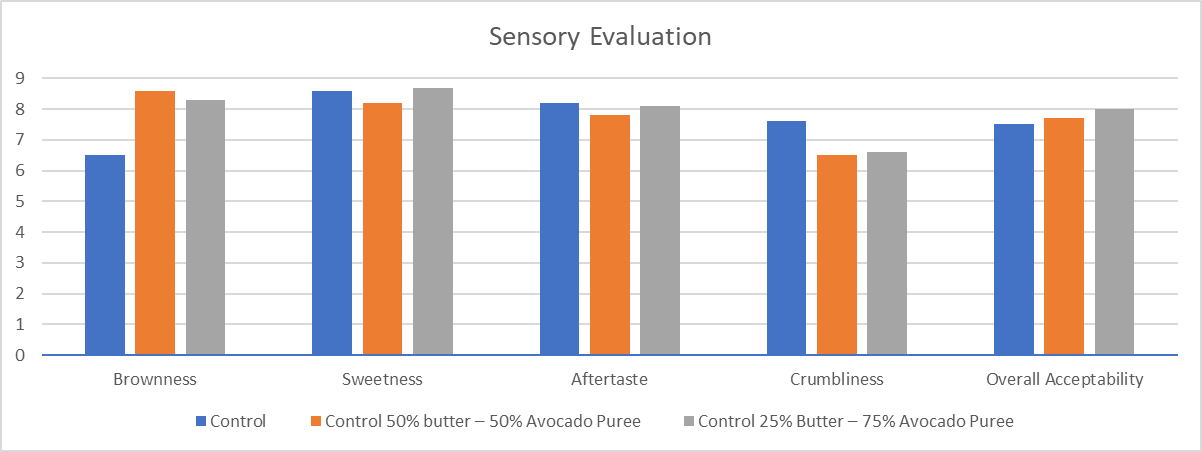
*Mean of 10 panelists using a 9-point scale (1: Weak, 9: Strong; overall acceptability- 1: dislike extremely, 9: like extremely); for Brownness the 9-point scale (1: Light Brown, 9: Dark Brown). Sample formulations found in Table 1.

Brownness
It has been observed that there was a significant difference (P>0.05) in the control and the sample prepared with the modification of avocado puree. The control sample had yellow colored cookies with the light brownness after baking whereas the modification 1 and 2 had green color and more brown appearance as compared to control sample. This might be due to the Millard browning reaction in the cookies contain high avocado content. Another study showed the same results stated, “Avocado substitution over 25% showed significant differences (p<0.05) in the L*, a* and b* values of muffin color components. The muffin crumbs were darker, lower in redness and yellowness than the muffin with avocado substitution below 25%. (Nurul Ain, Marina, Sakinah 2016).
Sweetness
The sweetness doesn’t have significant difference (P>0.05) in all three samples. The mean value for control was 8.60 whereas for modification 1 and 2 it’s 8.20 and 8.70 respectively that shows sweetness did not get affected by changing the fat source.
Crumbliness
There was no significant difference between the modified samples but compared with control modification 1 and 2 had significant difference. The control sample had highest mean (7.60), whereas 75% avocado had mean score of 6.60 and 50% avocado sample with the lowest score, 6.50. The control sample was crispier as compare to the 50% avocado and 75% avocado samples which was more like a cake-like texture and moister content was higher. Similar results were observed by P. Mohan, I. Mukherji and S. Jain (2018).
Overall Acceptability
The overall acceptability also doesn’t have significant difference for all the three samples (p>0.05). In fact, the mean value of modification 2 (25% butter 75% avocado Puree) was higher (8.00) as compared to control sample (7.50) and modification 1 (7.70). That could be due to the moist and cake like texture as other study found the same results such as “The physical and overall acceptability were found to be similar for all with improved nutritional content in the variations.” (Mohan, Mukherji, Jain 2018).
Diameter Measurement
The diameter measurement results are presented in Table 4 and Figure 2. The results showed statistically significant differences between any pair of treatment groups and control group in diameter size (p<0.05). However, the 50% butter 50% avocado puree samples and 25% butter 75% avocado Puree samples had no significant difference in diameter size.
Table 4. Diameter measurements of chocolate chip cookies prepared by replacing Butter with Avocado Puree. (Mean*± SD, unit: cm).
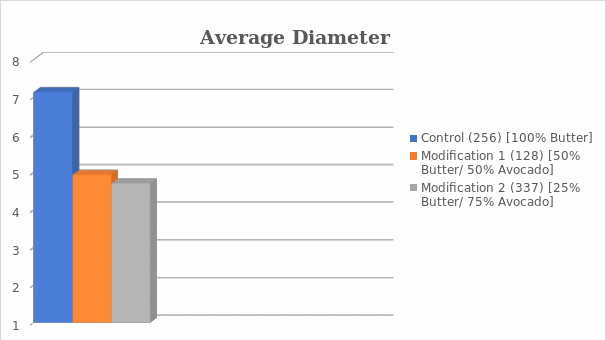
Means of 3 measurements.
There was a significant difference (p<0.05) in the diameter of all the three samples. The control had highest mean value (7.13) whereas the modification 1 and 2 had not much difference in there mean values (4.93 & 4.70) as mentioned in the table 4. That could be due to the high viscosity which effected the spread rate of modification 1 (50% butter 50% avocado puree) and 2 (25% butter 75% avocado Puree) during baking. As mentioned in other study, “Cookie spread rate appears to be controlled by dough viscosity (Yamazaki, 1959, Hoseney et al., 1988, [30, 23, 22] Hoseney and Rodger, 1994; Miller, 1997). Results of the studies indicated that there is a difference between each sample in terms of weight, diameter, height and spread ratio. The cookie weights were found to decrease, and the lowest weight was indicated in the cookie which had highest amounts of avocado puree (V3). This result suggested that the cookie V3 had high water holding capacity (WHC) as compared to V1, V2 and control cookies due to the higher avocado content. (Mohan, Mukherji, Jain 2018).
Nutrition Facts
By observing the nutrition facts figure 3 for all the three samples of chocolate chip cookies, it has been observed that the calories per serving has been decreasing in all 3 samples. Cookies prepared with 100% butter has higher calories (111.2) whereas 50% Butter/ 50% Avocado sample has 94.4 and 25% Butter/ 75% Avocado has lowest calories (85.9). Also, the fat content is decreasing from control sample (5.7g) to 25% Butter/ 75% Avocado sample (2.7g). By observing the cholesterol levels, 100% butter has higher cholesterol (22mg) whereas 50% Butter/ 50% Avocado sample has 15.9mg cholesterol level and 25% Butter/ 75% Avocado has lowest cholesterol level (12.9). Protein and carbohydrate content had no significant difference which is 1.2g protein and 5% carbs in all three samples. As same results have been found by other study, “The organoleptic tests showed highest acceptability for V2 (50% fat substitution with avocado). Also, V2 showed a 5% decrease in the total fat content compared to the control. This study thus suggests the use of avocado puree as a potential fat replacer for bakery or similar products.” (Mohan, Mukherji, Jain 2018)
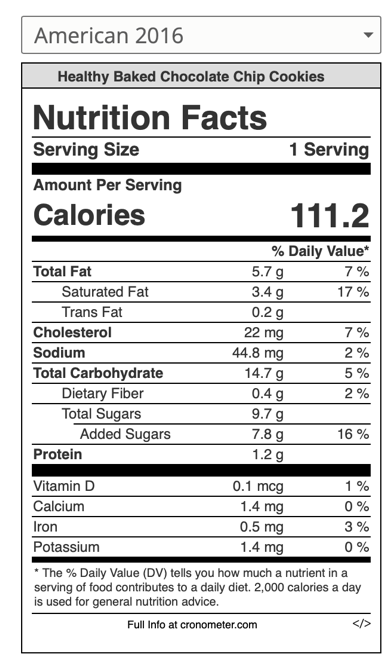
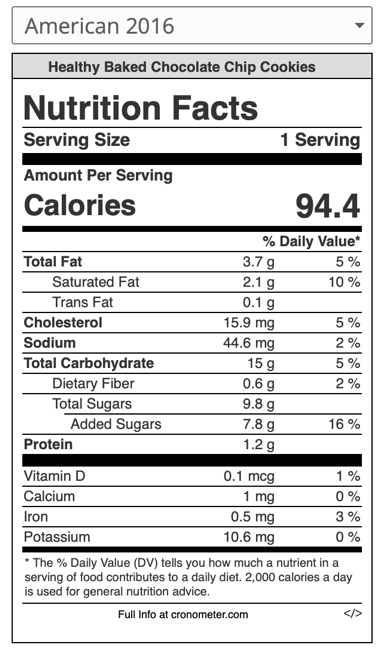
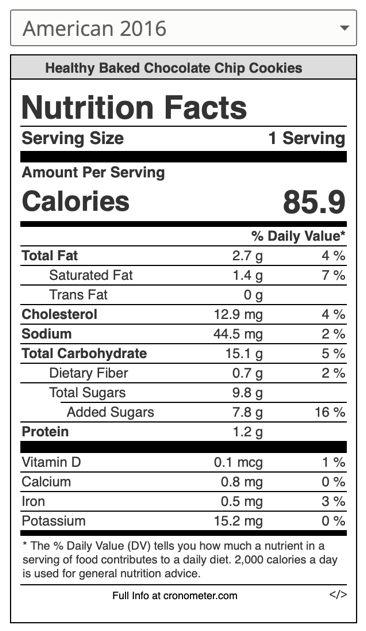
Conclusion
In conclusion, it has been observed that the cookies prepared by substituting butter with avocado puree showed significantly lowered results in brownness and diameter. Whereas, there was no significant difference in sweetness, crumbliness and overall acceptability. Moreover, the nutrition content such as calories, fats and cholesterol value showed there was significance decrease in cookies prepared with avocado puree as compared to control (100% butter).
Hence, the study successfully proved that the purpose of this study has been achieved. By substituting, butter with avocado puree in chocolate chip cookies provides you the healthy food option without affecting the overall acceptability.
References
Othman, N., Abdul Manaf, M., Harith, S., & Ishak, W. (2018): Influence of Avocado Purée as a Fat Replacer on Nutritional, Fatty Acid, and Organoleptic Properties of Low-Fat Muffins, Journal of the American College of Nutrition. Web.
Mohan,P., Mukherjee, I. & Jain, S.(2018). Study on the physio-chemical and sensory characteristics of cookies made using avocado as a fat (Butter) substitute. International Journal of Food Science and Nutrition. 3(1), 68-72.
Colla, Kathryn, et al. “Fat Replacers in Baked Food Products.” Foods (Basel, Switzerland), MDPI, 2018.
Cronometer. (n.d.).